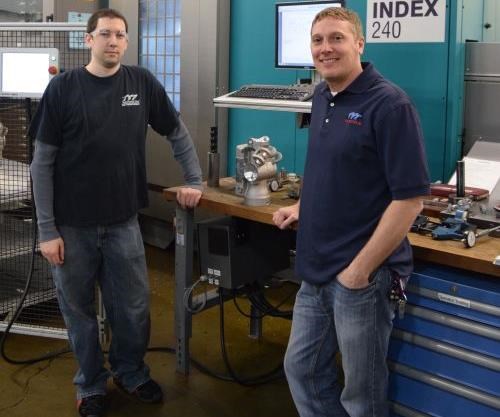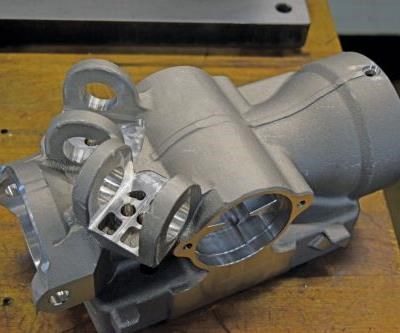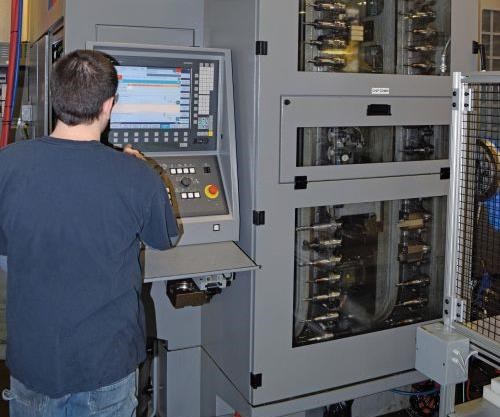Multitasking is More Than Doing Two Things at Once
Combining different metalcutting operations on a single machine platform is helping shops explore better ways to manufacture.
Finding better, more efficient and more profitable ways to produce parts and keep a competitive advantage is a daily pursuit at successful shops. It’s no different at Task Force Tips (TFT), Valparaiso, Indiana, which makes multiple nozzle sizes and designs, valve bodies, and other components for fire suppression and water delivery equipment for the forestry, municipal and industrial firefighting markets as well as for aircraft deicing. As a result, TFT does many short runs of hundreds of different part designs.
Founded in 1971, the closely held company is dedicated to creating the means for firefighters to be as effective as possible in dousing flames, performing engineering, machining, assembly and testing. Within its fully integrated production plant, about 98 percent of the work is done in-house by more than 200 employees.
Exceeding Expectations
TFT is a team-oriented workforce encouraged by Chairman/CEO Stewart McMillan. Through the years, the company invested in a range of automatic lathes from Index Corp. that have created opportunities for programmers and operators to come up with better processes. “Index created for us an opportunity that was game-changing for our company,” Mr. McMillan says.
TFT runs six C series automatic lathes that Mr. McMillan says produce parts that would normally be mistaken as parts that came off a machining center.
The company first invested in CNC machining back in 1980 and has since been investing in increasingly capable machines for increasingly automated processes. “The multitasking capabilities of these newer machines has made a fundamental shift in how people think in the machining side of TFT,” says Cory Mack, production supervisor.
Beyond Turn-Mill
Most recently, TFT began using a simultaneous five-axis turn-mill that has allowed the company to further reduce cycle times for key parts, which it never could have imagined—despite the company’s experience with top turn-mills. The result has been improved part quality, even less processing time per finished part, and expanded production capacity in the already well-equipped shop.
There are not only one, but two Index R300 five-axis turn-mills at TFT. The machine uses two independent five-axis subsystems, each with one motorized milling spindle and one assigned work spindle, and is able to completely machine complex parts, bar capacity up to 102 mm (4.01 inches) and chucking as large as 315 mm (12.4 inches) in diameter, simultaneously. The machine is geared toward applications where large chuck parts require a lot of milling and drilling work, such as farm machinery and machine construction, in toolmaking, moldmaking or in the aerospace industry.
From simple to highly complex components, the main benefit is that the complex machining operations are possible simultaneously on the front and rear side, and, at the same time, are highly productive with the two motorized milling spindles.
The R300 is also capable of hobbing or deep-hole drilling with single-lip tools and high pressure coolant to 80 bar to the tool edge through the motorized milling spindle.
Many Tools Shorten Processing Times
TFT can carry out full backworking as well as parallel machining with identical sequences. Both heavy-duty roughing operations and fine-turning operations can be completed simultaneously on the main spindle and counterspindle. A large-capacity toolchanger (as much as 140 tools in the double-chain magazine) ensure short setup times even for small batches. The tool storage capacity also allows TFT to store enough tools for complete processing of several different parts. Change-over is only a matter of choosing the program.
“The 12 stationary tools on the tool strips of both milling spindles bring the total number of tools to 152 tools available for a virtually unlimited range of operations and machining flexibility,” Mr. Mack says. Both milling spindles can perform tool changes completely independently of one another. The use of HSK toolholders reduces the tool costs, as live toolholders are no longer necessary.
The option of operating the machine with a short bar loader with few personnel is only one of several automated handling solutions. For handling a large series of chuck parts, TFT has outfitted the machines with integrated robot loading.
A rigid system, the R300 is less susceptible to vibration. This characteristic has a positive effect on the precision of the finished parts and on the tool life, allowing TFT to produce clean, smooth surfaces and eliminating secondary deburring of critical bores.
The two quill-guided motorized milling spindles are located in the center of the machine bed. Because of the axes arrangement, conventional cross-slides with tool carriers are no longer necessary. When combined with the play-free and wear-free hydrostatic circular guide, the system has a high stiffness.
The B-axis swivel range of 270 degrees and the rapid traverse rate of 45 m/min support machining flexibility and high-speed operation at TFT. The identical turning spindles with the same synchronous design have a maximum power rating of 47 kW, a maximum speed of 3,500 rpm and a peak torque of 690 Nm.
Learning by Doing
TFT started this quest for efficient multitasking in the early 1990s, and lessons learned helped the company move forward.
When the Blitzfire XX600 aluminum nozzle body was introduced by TFT, the company machined it in four operations in 2.5 hours per piece in two lathe operations and two mill operations.
“The first two operations on the lathe were boring and secondary boring, plus milling detail, which is very time consuming,” Mr. Mack says. “The first operation was expensive because we had to have our highest paid personnel setting it up and running it; the bore had to be indicated on each casting. Shimming the casting and tapping it around with a brass hand tool to get it located was how we got the initial correct runout set on the parts.”
Its second operation was easier to locate, and it allowed loading the part onto a precision ID workholder. Milling was next, which required two operations on a third and different machine because operators could not reach all the features on the horizontal lathe without doing the process in two operations.
“All these operations created burrs, which required a secondary manual deburring operation so it could be assembled,” Mr. Mack says. “All these operations and part handling amounted to 2.5 hours per part, not including deburring.”
Then, the operators put the part on another multitasking machine: this one with one turret and one motorized mill head. At this point, they also started with Esprit CAD/CAM software. And although the part was done in one operation, the cycle time was still about 35 minutes.
“It was a nice improvement for us, but the machine had some clearance issues, and the operators could not get all the deburring done on it,” Mr. Mack says. “And it had some extreme tool overhangs.”
Then, TFT management saw the R300 five-axis turn-mill at an IMTS (International Manufacturing Technology Show) and made a purchase.
Once implemented in the shop, the new R300 was utilized to machine the nozzle body. “We were not looking for a tremendous improvement in cycle time, but we did like the possibility of simultaneous machining with two motorized mill heads,” Mr. Mack says. “We put some of our large-volume parts (5,000 parts per year) on the machines—couplings and nozzles that require a range of milling, turning, threading operations. With its large-tool capacity, the machines can work unattended.”
The company’s two R300s eliminate the need for four multitasking machines.
Unexpected Benefits
TFT management discovered the R300 provided a lot more opportunity for process improvement than expected—simultaneous complete machining, reaching all the features of the part plus a deburring pass—all in one setup. This turn-mill machined the XX600 nozzle body in 15 minutes complete, including deburring. The company saved not only cycle time, but man hours in deburring.
A loading robot was also added to the mill-turn machine. “Parts are staged, and the robot self-loads. This allowed process improvement on this part,” Mr. Mack says. “Once you have the machine programmed and take the human element out of the operation (deburring), you really save time.”
TFT thought it could shorten the cycle time, but it had not considered the rigidity of the machine and its positive effect on the part quality and the capability of the two milling heads for simultaneous machining. Plus, the tool magazine location and capacity supports fast, more complete processing of the company’s parts. Even simple parts are run faster, according to the company.
With more machining capability, the design engineers start figuring out what the manufacturing floor is capable of. The engineers have a feel for what can be done on the shop floor, and they design parts to take advantage of that. The result is improved designs and improved quality for TFT’s customers.
CNC and User-Friendly Software
The machine’s CNC is based on the Siemens Sinumerik S840D line and was enhanced by Index with user-friendly features. Specially developed cycles simplify even the most complex machining operations, supporting multi-axis milling and turning operations and providing maximum functional reliability.
“There are so many features of the Siemens control that when tied to Esprit software, it became the easiest machine to set up of all the turn-mills,” Mr. Mack says. “Our programmer has told us that when he looks at a part that he does not think will run faster on the Index machines, he ends up cutting the time in half. And when he sees a job that is well-suited, it can cut the time by as much as 70 percent.”
Not So Tough Programming
Learning the programming to machine the XX600 nozzle body was not difficult, according to Brandon Marcotte, operator and programmer at TFT. “We split the program into two copies that allowed simultaneous machining, and with the R300 turn-mill to get the time to 14 minutes. The robot, with 10-kg capacity, loads one part at a time, taking the finished part off while the machine internally transfers the part from one side to the other. Seems like a big animal, but it was not really.”
Mr. Marcotte says the biggest challenge programming the Index machine is balancing the work load between the two heads so he could get the most benefit out of each. “We were familiar with the control. We have used Siemens controls, and in our experience, it is quicker and more advanced than most, without over-complicating the process,” he says.
TFT had the Index Virtual Machine simulation software installed on Mr. Marcotte’s computer before he received the R300, so he could optimize the program and test the posts with the fully simulated machine before the actual machine arrived. “Using the simulation allowed us to prove out posts and test the program before the machine hit the shop floor, so we were ready to run,” he says.
“The software made it one of the smoothest machine installations we’ve ever had, and because the simulation is specific to the machine, it is reliable. It is the machine control itself, unlike other general programming simulation software,” Mr. Marcotte says.
“All this capability has put us very far ahead in machining capacity, and we have the ability to do more,” Mr. Mack says. “It’s not that we bought a ton of new machines—it’s that we bought the right machines.”
At TFT, highly capable multitasking machines help conserve valuable capital dollars for the company and permit it to turn out high quality parts in short cycles, resulting in lower per-piece cost.
Related Content
Precision Machining Technology Review: September 2024
Production Machining’s September 2024 technology showcase includes some of the latest technology from Expand Machinery, Paperless Parts, Monaghan Tooling Group, Walter USA and more.
Read MoreWhen a CNC Turn-Mill Doesn’t Turn
A shop in Big Sky Country uses a B-axis multitasking machine to produce complex, prismatic medical parts that require no turning complete from barstock.
Read MoreA Mill-Turn’s Value for Machining Micro Gears
This leading manufacturer of non-lubricated robotic gears uses a seven-axis turn-mill to machine components from “amorphous” metals such as bulk metallic glasses.
Read MoreChoosing the Right Machine for Turned and Milled Medical Parts
The medical market is known for exceptionally tight tolerances and difficult materials, which means that selecting the proper machine is necessary to ensure a job is profitable.
Read MoreRead Next
5 Aspects of PMTS I Appreciate
The three-day edition of the 2025 Precision Machining Technology Show kicks off at the start of April. I’ll be there, and here are some reasons why.
Read MoreEmerging Leaders Nominations Now Open
Here’s your chance to highlight a young person in your manufacturing business who is on the path to be a future leader moving your company forward.
Read MoreDo You Have Single Points of Failure?
Plans need to be in place before a catastrophic event occurs.
Read More










.jpg;maxWidth=300;quality=90)



.jpg;maxWidth=300;quality=90)









